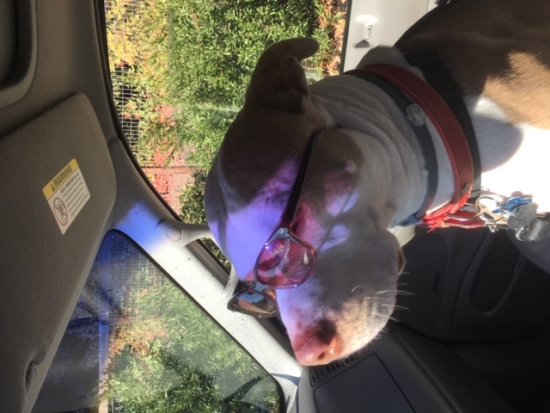| | Published August 2nd, 2023
| Tips for pet safety during hot summer months
| | | By Vera Kochan |  | | "Buddy" chooses to stay "cool" with sunglasses. Photo Lorna Kochan |
It's difficult enough for humans to stay cool and escape the heat of summer, but it's also important to remember our four-legged friends can suffer from the effects of high temperatures, too.
 The Humane Society of the United States reminds pet owners to never leave pets in a parked car. "Not even for a minute! Not even with the car running and air conditioning on. On a warm day, temperatures inside a vehicle can rise rapidly to dangerous levels. On an 85-degree day, for example, the temperature inside a car with the windows opened slightly can reach 102 degrees within 10 minutes. After 30 minutes, the temperature will reach 120 degrees. Your pet may suffer irreversible organ damage or die."
The Humane Society of the United States reminds pet owners to never leave pets in a parked car. "Not even for a minute! Not even with the car running and air conditioning on. On a warm day, temperatures inside a vehicle can rise rapidly to dangerous levels. On an 85-degree day, for example, the temperature inside a car with the windows opened slightly can reach 102 degrees within 10 minutes. After 30 minutes, the temperature will reach 120 degrees. Your pet may suffer irreversible organ damage or die."
 It's not just high summer temperatures that can adversely affect your pet; high humidity can make them unable to cool themselves. Animals pant to evaporate moisture from their lungs, and they sweat through their feet. Too much humidity won't allow them to cool down, which in turn raises their temperatures. A dog's temperature should never climb above 104 degrees.
It's not just high summer temperatures that can adversely affect your pet; high humidity can make them unable to cool themselves. Animals pant to evaporate moisture from their lungs, and they sweat through their feet. Too much humidity won't allow them to cool down, which in turn raises their temperatures. A dog's temperature should never climb above 104 degrees.
 HSUS also cautions pet owners about over-exercising their pets. Either early morning or evening hours are the coolest times to be outdoors for animals as well as their owners, and bring extra water along for both to keep from dehydrating. Be especially mindful of pets with white-colored ears, as they are more susceptible to skin cancer, and short-nosed pets tend to have difficulty breathing in the heat. Also, older dogs, just like humans, might not be able to handle high temperatures.
HSUS also cautions pet owners about over-exercising their pets. Either early morning or evening hours are the coolest times to be outdoors for animals as well as their owners, and bring extra water along for both to keep from dehydrating. Be especially mindful of pets with white-colored ears, as they are more susceptible to skin cancer, and short-nosed pets tend to have difficulty breathing in the heat. Also, older dogs, just like humans, might not be able to handle high temperatures.
 According to HSUS, if a pet has to be outside, try to keep it in the shade or under tarps to take advantage of any air flow. Lack of air flow also makes a doghouse a dangerous place during a heat wave.
According to HSUS, if a pet has to be outside, try to keep it in the shade or under tarps to take advantage of any air flow. Lack of air flow also makes a doghouse a dangerous place during a heat wave.
 DoveLewis, an Oregon-based nonprofit ICU & ER Animal Hospital, reminds pet owners to "protect your pet's paws from hot surfaces. Walk your pet in the grass or the shade whenever possible. If the pavement is too hot for your bare hands or feet, it's too hot for your pet's paws."? Additionally, "If you need to take them outside to do their business, try wetting the surface with a hose or water bottle to help make it a little cooler for them."
DoveLewis, an Oregon-based nonprofit ICU & ER Animal Hospital, reminds pet owners to "protect your pet's paws from hot surfaces. Walk your pet in the grass or the shade whenever possible. If the pavement is too hot for your bare hands or feet, it's too hot for your pet's paws."? Additionally, "If you need to take them outside to do their business, try wetting the surface with a hose or water bottle to help make it a little cooler for them."
 DoveLewis also recommends using a pet-safe sunscreen on unprotected areas such as the tips of the ears, the skin around the lips, and the tip of the nose. If a sunscreen is safe for babies, it will also work for pets.
DoveLewis also recommends using a pet-safe sunscreen on unprotected areas such as the tips of the ears, the skin around the lips, and the tip of the nose. If a sunscreen is safe for babies, it will also work for pets.
 Heatstroke in animals can be just as dangerous as it is for humans. Panting, vomiting, excessive drooling, warm and dry skin, rapid heartbeat, staring or anxious expressions, uncoordinated movements or collapse require urgent attention. "Owners who suspect their pets may be experiencing heatstroke should call their regular veterinarian immediately," states DoveLewis. "In the meantime, you can: lower your pet's body temperature by applying towels soaked in cool water to the hairless areas of the pet's body (the tips and back of the ears, foot pads, belly, and inner thighs). Do not use ice or extremely cold water because that can worsen the problem."
Heatstroke in animals can be just as dangerous as it is for humans. Panting, vomiting, excessive drooling, warm and dry skin, rapid heartbeat, staring or anxious expressions, uncoordinated movements or collapse require urgent attention. "Owners who suspect their pets may be experiencing heatstroke should call their regular veterinarian immediately," states DoveLewis. "In the meantime, you can: lower your pet's body temperature by applying towels soaked in cool water to the hairless areas of the pet's body (the tips and back of the ears, foot pads, belly, and inner thighs). Do not use ice or extremely cold water because that can worsen the problem."
 Another tip is to "use a fan to help cool the animal. Even if the pet seems to cool down, it's still imperative to visit a veterinarian immediately, as temperatures often spike again or cool below a safe, normal temperature."
Another tip is to "use a fan to help cool the animal. Even if the pet seems to cool down, it's still imperative to visit a veterinarian immediately, as temperatures often spike again or cool below a safe, normal temperature."
 In 2016, California passed a law prohibiting anyone from leaving an animal in "any unattended motor vehicle under conditions that endanger the health or well-being of an animal."
In 2016, California passed a law prohibiting anyone from leaving an animal in "any unattended motor vehicle under conditions that endanger the health or well-being of an animal."
 California penal code 597.7 states that endangering conditions include lack of ventilation, heat, cold, lack of food or water, or "other circumstances that could reasonably be expected to cause suffering, disability, or death to the animal."
California penal code 597.7 states that endangering conditions include lack of ventilation, heat, cold, lack of food or water, or "other circumstances that could reasonably be expected to cause suffering, disability, or death to the animal."
 A "Good Samaritan Law," AB 797, also known as the Right to Rescue Act, allows a person to break into a vehicle if the vehicle is locked or there is otherwise no reasonable manner for the animal to be removed from the vehicle, the animal is in imminent danger of suffering harm if it is not immediately removed from the vehicle, the rescuer has contacted a local law enforcement agency prior to forcibly entering the vehicle; and the rescuer stays at the scene until local law enforcement responds to the situation.
A "Good Samaritan Law," AB 797, also known as the Right to Rescue Act, allows a person to break into a vehicle if the vehicle is locked or there is otherwise no reasonable manner for the animal to be removed from the vehicle, the animal is in imminent danger of suffering harm if it is not immediately removed from the vehicle, the rescuer has contacted a local law enforcement agency prior to forcibly entering the vehicle; and the rescuer stays at the scene until local law enforcement responds to the situation. |
| | | | | | | | | | | | |



